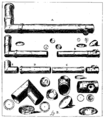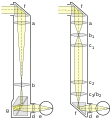Periscope
![]()
This article or section is still missing the following important information:
There is a lack of historical (first use, constructional development) and technical information on the application in military and civilian navigation, usual/maximum lengths of the sighting tube, usual/maximum sighting tube depths, seals of the retractable/extendable sighting tube, telescoping capability, etc. pp
Help Wikipedia by researching and adding them.
![]()
The title of this article is ambiguous. For a lens of the same name, see Periscope (lens).
The periscope (from Ancient Greek περί peri, German 'around, about' and σκοπεῖν skopein 'to look') or periscope, simplified also Wallgucker, is an optical instrument for the parallel displacement of the ray path. The invention goes back to Johannes Hevelius, who published it in 1647 in his printed work Selenographia sive Lunae Descriptio under the name Polemoscope (see drawing).
Applications
The periscope is mainly used for military purposes, for example to be able to look out safely from bunkers, trenches (here also scissors telescope) and submarines. Also hovercrafts use this technique, because at higher altitudes there is no more churned up water to restrict the view. The Spirit of St. Louis aircraft also had a periscope for the pilot. Angled mirrors are often used in armored vehicles.
· 
Periscope on a submarine
· 
Attack periscope and night periscope on a submarine
· 
View through a periscope
· 
Periscope in a bunker
· 
Angle scope on a tripod
· 
Periscope on a Soyuz spacecraft
Structure and mode of operation
The basic structure of a periscope consists of a tube with mirrors or prisms arranged at both openings. These deflect light rays running perpendicular to the tube into the tube and out again with a parallel offset to the original direction of incidence. An observer looking into the lower opening of a periscope thus gets the impression of looking at the surroundings from higher up. The mirrors are arranged at an angle of 45° to the incoming and outgoing light beams, which causes a right-angle deflection. The reflectance of metallized mirror surfaces is not considered perfect and continues to deteriorate over the course of months. In contrast, the totally reflective diagonal surfaces of prisms have better and sustained reflectance and are preferred.
This simple design leads to a too small field of view with longer periscopes. Periscopes equipped with lens systems can extend the field of view many times over by using a suitable field lens.
Two such periscopes are shown schematically below. The arrangement of the lenses corresponds in principle to that of a telescope with low magnification. Often a magnification factor of 1.5 is chosen, which for psychological reasons gives the impression of a natural, 1-fold magnification. However, since the image in simple telescope systems always appears rotated by 180°, either a reversing prism (g) or reversing lenses (c) are used to reverse the image - as in binoculars or telescopes for terrestrial observation.
In periscopes of the second type, a pair of reversing lenses (c1 and c2) can be arranged so that the beam path between them is parallel. This allows the length between c1 and c2 to be varied over a wide range without affecting the image (e.g., for different exit heights of a submarine periscope).
If the second field lens (c3/b2) is positioned slightly above the intermediate image (it thus takes over part of the task of the reversing lenses), there is room for a crosshair at the location of the intermediate image, which appears sharp in the image as a sight. For night observations, it can be illuminated from the side.
· 
Drawing of a periscope with lenses from Selenographia sive Lunae Descriptio, 1647, Johannes Hevelius
· 
Simple operating principle of the periscope with mirrors (a) or deflecting prisms (b).
· 
Periscopes with lens system
a objective lens
b Field lenses
c Reversing lenses
d Eyepiece lens
e Eye lens
f Deflecting prism
g Inverting prism
Search within the encyclopedia